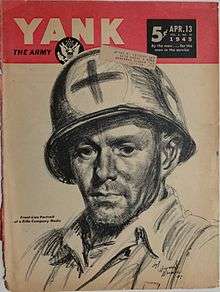Howard Brodie
Howard Brodie (November 18, 1915 – September 19, 2010) was a sketch artist best known for his World War II combat and courtroom sketches.
Howard Brodie | |
|---|---|
| Born | November 18, 1915 |
| Died | September 19, 2010 (aged 94) |
| Nationality | American |
| Alma mater | California School of Fine Arts |
| Occupation | Sketch artist |
| Employer |
|
Pre-war career
Brodie was born in Oakland, California, United States, on November 18, 1915. He briefly attended California School of Fine Arts, San Francisco. When World War II started, Howard Brodie was a sports artist for the San Francisco Chronicle. Brodie also enjoyed success as an illustrator of college football program covers.
Combat sketches

With entry of the United States into World War II, Brodie enlisted in the Army. He became one of Yank magazine's best-known artists during the war. He sketched everything from Guadalcanal to the Battle of the Bulge and had an uncanny ability to capture the emotions of his subjects and record a scene with great attention to detail.
He put himself in combat situations many times and, while he never carried a weapon, worked as a medic when needed. He received the Bronze Star for valor.[1]
Courtroom sketches
After the war Brodie became a courtroom artist and recorded many famous trials, including those of the Chicago Seven, Charles Manson and General Westmoreland, the Ruby trial and Senate Civil Rights Debates. He was also a CBS TV Artist-Correspondent. Brodie never fully severed his ties to the military and was a combat artist in Korea, French Indochina, and Vietnam. His works can be found in the Library of Congress.
Famous works
Two of Brodie's most famous works are "Portrait of a Medic", which appeared on the cover of Yank Magazine, and "Compassion". Another sketch, which depicted an exhausted G.I. dropping his rifle as World War II ended, appeared on the cover of Yank’s Continental Edition on August 19, 1945. Brodie's works are collected in Drawing Fire: A Combat Artist at War Pacific Europe Korea Indochina Vietnam.
As The New York Times has stated, "His sketch of the black militant Bobby Seale gagged and strapped to his chair became the image that epitomized the trial of the Chicago Seven, the leaders of protests at the 1968 Democratic National Convention."[1]
Notes
- William Grimes (September 24, 2010). "Howard Brodie, 94, Combat and Courtroom Artist, Dies". The New York Times.
External links
| Wikimedia Commons has media related to Howard Brodie. |